KIDDYLICIOUS: Digital Strategy Analysis and Recommendations
VerifiedAdded on 2022/09/10
|12
|2672
|40
Report
AI Summary
This report provides a comprehensive analysis of KIDDYLICIOUS, a UK-based SME food manufacturer, focusing on its digital strategy. The analysis includes PEST and SWOT analyses to evaluate the company's current digital marketing efforts, which primarily utilize social media platforms like Instagram, Twitter, and Facebook, along with its website and SEO marketing. The report critically assesses the strengths and weaknesses of the existing strategies while identifying opportunities for improvement, such as leveraging Facebook more effectively, regularly updating users, capitalizing on market trends, and incorporating YouTube marketing. Recommendations are provided to enhance market competitiveness and sustainability, suggesting a more integrated and advanced digital strategy to address potential threats and exploit opportunities for growth in the competitive food industry.
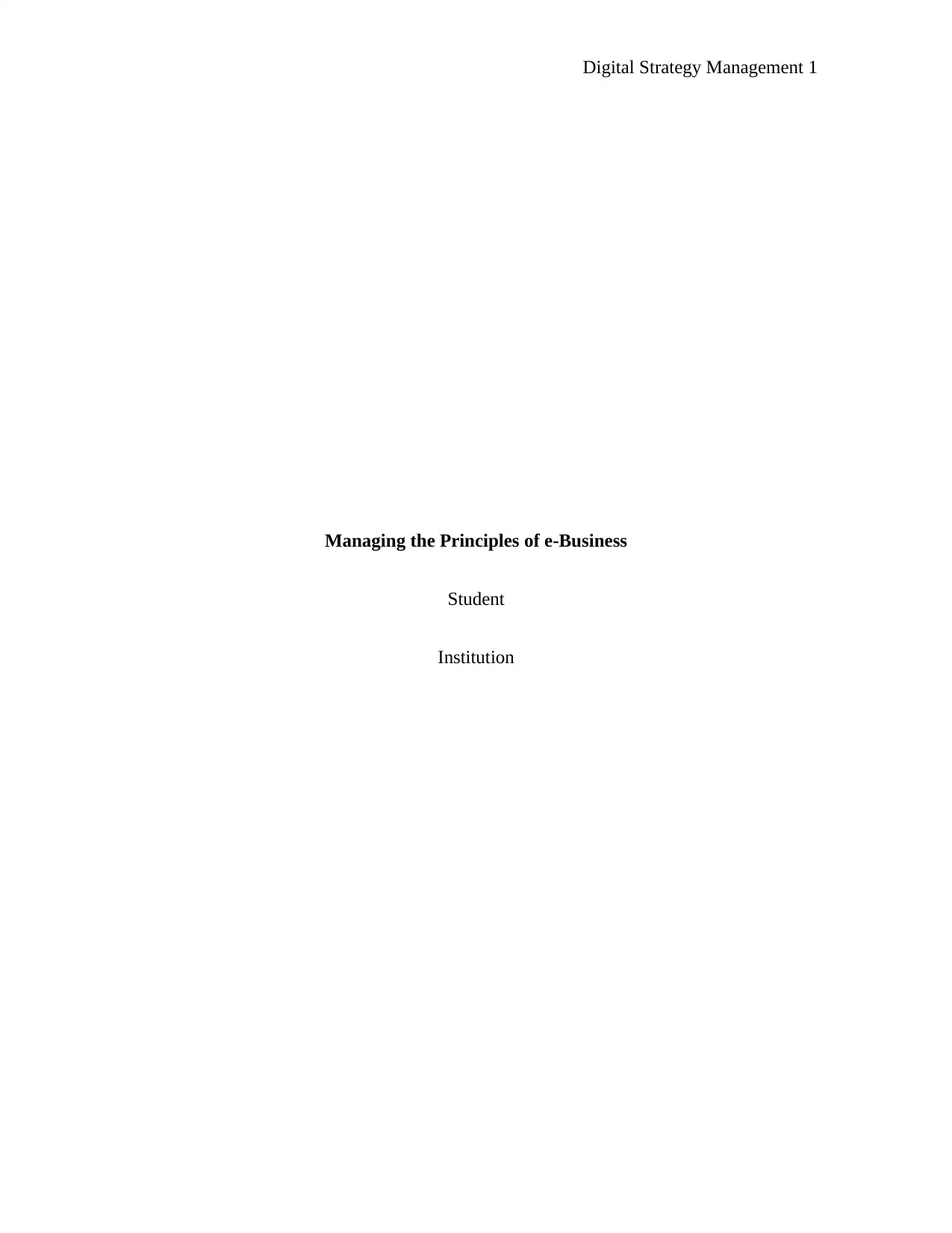
Digital Strategy Management 1
Managing the Principles of e-Business
Student
Institution
Managing the Principles of e-Business
Student
Institution
Paraphrase This Document
Need a fresh take? Get an instant paraphrase of this document with our AI Paraphraser
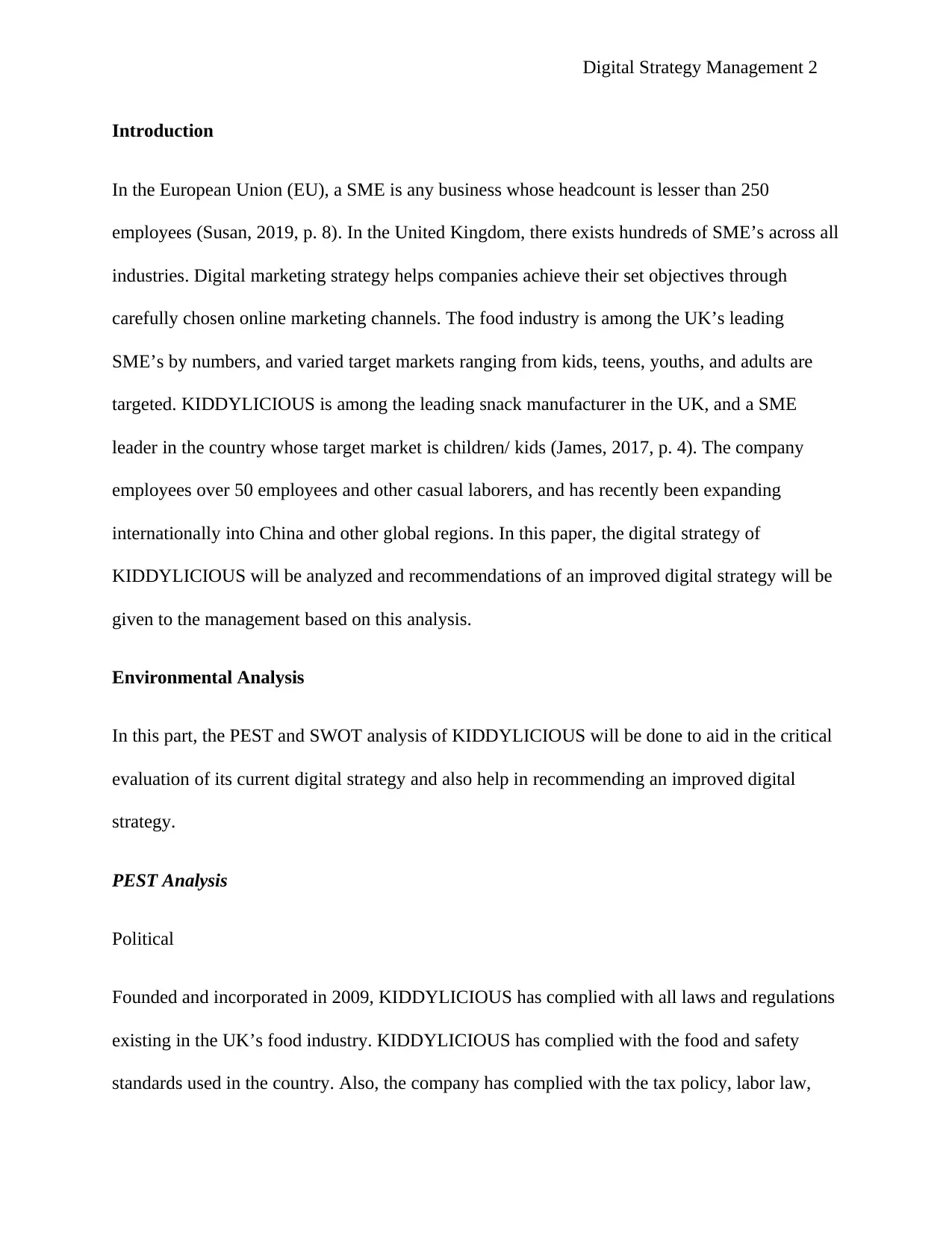
Digital Strategy Management 2
Introduction
In the European Union (EU), a SME is any business whose headcount is lesser than 250
employees (Susan, 2019, p. 8). In the United Kingdom, there exists hundreds of SME’s across all
industries. Digital marketing strategy helps companies achieve their set objectives through
carefully chosen online marketing channels. The food industry is among the UK’s leading
SME’s by numbers, and varied target markets ranging from kids, teens, youths, and adults are
targeted. KIDDYLICIOUS is among the leading snack manufacturer in the UK, and a SME
leader in the country whose target market is children/ kids (James, 2017, p. 4). The company
employees over 50 employees and other casual laborers, and has recently been expanding
internationally into China and other global regions. In this paper, the digital strategy of
KIDDYLICIOUS will be analyzed and recommendations of an improved digital strategy will be
given to the management based on this analysis.
Environmental Analysis
In this part, the PEST and SWOT analysis of KIDDYLICIOUS will be done to aid in the critical
evaluation of its current digital strategy and also help in recommending an improved digital
strategy.
PEST Analysis
Political
Founded and incorporated in 2009, KIDDYLICIOUS has complied with all laws and regulations
existing in the UK’s food industry. KIDDYLICIOUS has complied with the food and safety
standards used in the country. Also, the company has complied with the tax policy, labor law,
Introduction
In the European Union (EU), a SME is any business whose headcount is lesser than 250
employees (Susan, 2019, p. 8). In the United Kingdom, there exists hundreds of SME’s across all
industries. Digital marketing strategy helps companies achieve their set objectives through
carefully chosen online marketing channels. The food industry is among the UK’s leading
SME’s by numbers, and varied target markets ranging from kids, teens, youths, and adults are
targeted. KIDDYLICIOUS is among the leading snack manufacturer in the UK, and a SME
leader in the country whose target market is children/ kids (James, 2017, p. 4). The company
employees over 50 employees and other casual laborers, and has recently been expanding
internationally into China and other global regions. In this paper, the digital strategy of
KIDDYLICIOUS will be analyzed and recommendations of an improved digital strategy will be
given to the management based on this analysis.
Environmental Analysis
In this part, the PEST and SWOT analysis of KIDDYLICIOUS will be done to aid in the critical
evaluation of its current digital strategy and also help in recommending an improved digital
strategy.
PEST Analysis
Political
Founded and incorporated in 2009, KIDDYLICIOUS has complied with all laws and regulations
existing in the UK’s food industry. KIDDYLICIOUS has complied with the food and safety
standards used in the country. Also, the company has complied with the tax policy, labor law,
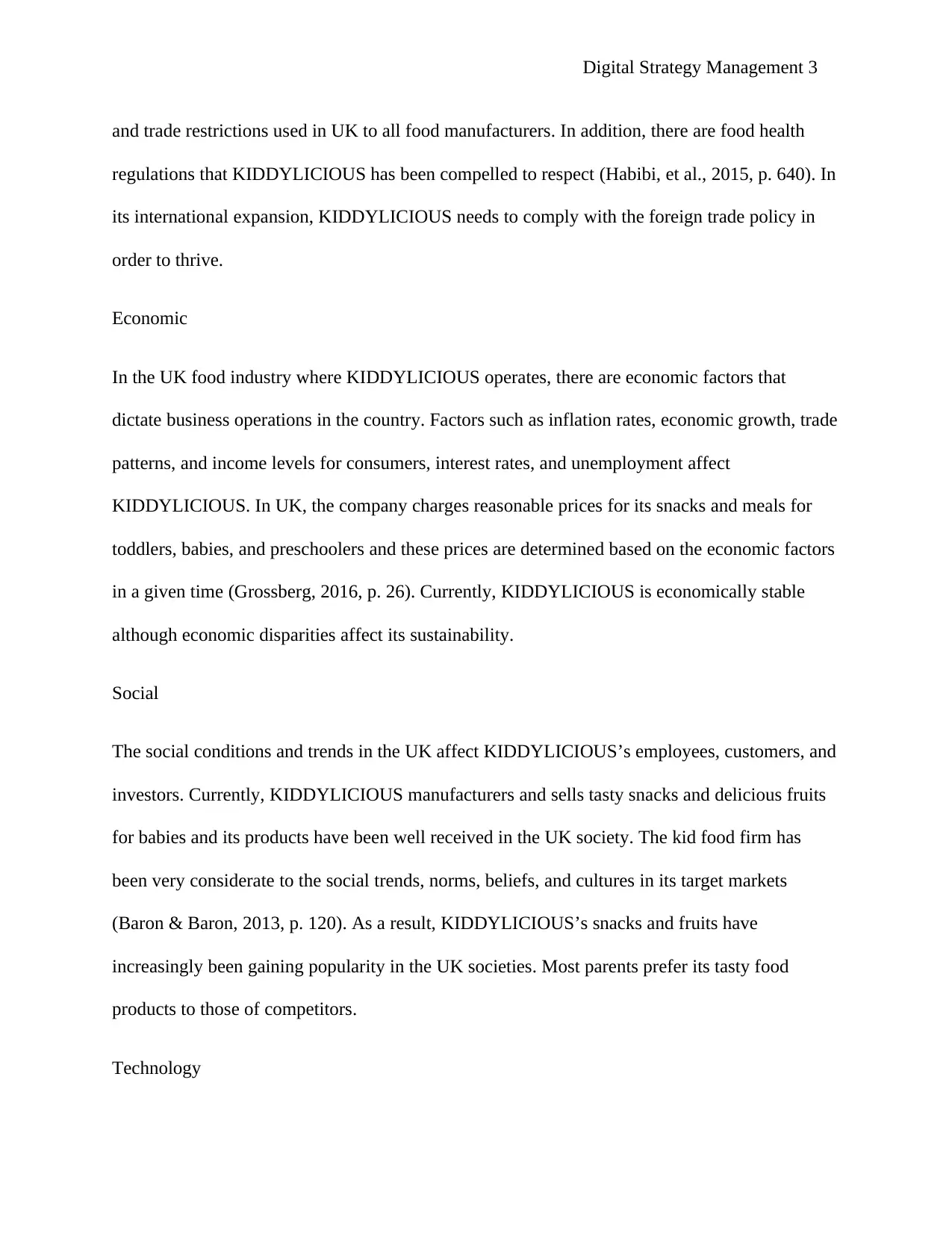
Digital Strategy Management 3
and trade restrictions used in UK to all food manufacturers. In addition, there are food health
regulations that KIDDYLICIOUS has been compelled to respect (Habibi, et al., 2015, p. 640). In
its international expansion, KIDDYLICIOUS needs to comply with the foreign trade policy in
order to thrive.
Economic
In the UK food industry where KIDDYLICIOUS operates, there are economic factors that
dictate business operations in the country. Factors such as inflation rates, economic growth, trade
patterns, and income levels for consumers, interest rates, and unemployment affect
KIDDYLICIOUS. In UK, the company charges reasonable prices for its snacks and meals for
toddlers, babies, and preschoolers and these prices are determined based on the economic factors
in a given time (Grossberg, 2016, p. 26). Currently, KIDDYLICIOUS is economically stable
although economic disparities affect its sustainability.
Social
The social conditions and trends in the UK affect KIDDYLICIOUS’s employees, customers, and
investors. Currently, KIDDYLICIOUS manufacturers and sells tasty snacks and delicious fruits
for babies and its products have been well received in the UK society. The kid food firm has
been very considerate to the social trends, norms, beliefs, and cultures in its target markets
(Baron & Baron, 2013, p. 120). As a result, KIDDYLICIOUS’s snacks and fruits have
increasingly been gaining popularity in the UK societies. Most parents prefer its tasty food
products to those of competitors.
Technology
and trade restrictions used in UK to all food manufacturers. In addition, there are food health
regulations that KIDDYLICIOUS has been compelled to respect (Habibi, et al., 2015, p. 640). In
its international expansion, KIDDYLICIOUS needs to comply with the foreign trade policy in
order to thrive.
Economic
In the UK food industry where KIDDYLICIOUS operates, there are economic factors that
dictate business operations in the country. Factors such as inflation rates, economic growth, trade
patterns, and income levels for consumers, interest rates, and unemployment affect
KIDDYLICIOUS. In UK, the company charges reasonable prices for its snacks and meals for
toddlers, babies, and preschoolers and these prices are determined based on the economic factors
in a given time (Grossberg, 2016, p. 26). Currently, KIDDYLICIOUS is economically stable
although economic disparities affect its sustainability.
Social
The social conditions and trends in the UK affect KIDDYLICIOUS’s employees, customers, and
investors. Currently, KIDDYLICIOUS manufacturers and sells tasty snacks and delicious fruits
for babies and its products have been well received in the UK society. The kid food firm has
been very considerate to the social trends, norms, beliefs, and cultures in its target markets
(Baron & Baron, 2013, p. 120). As a result, KIDDYLICIOUS’s snacks and fruits have
increasingly been gaining popularity in the UK societies. Most parents prefer its tasty food
products to those of competitors.
Technology
⊘ This is a preview!⊘
Do you want full access?
Subscribe today to unlock all pages.

Trusted by 1+ million students worldwide
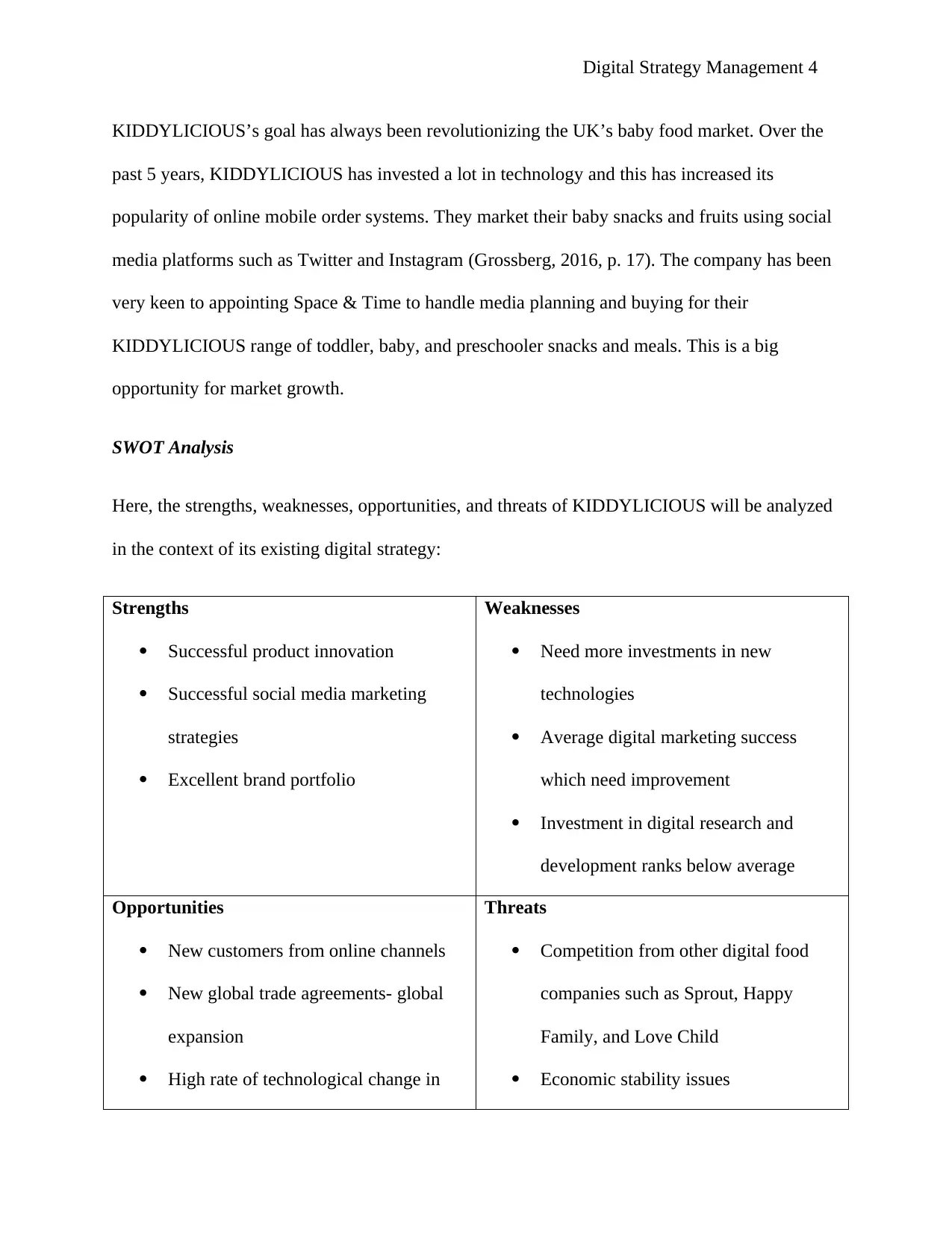
Digital Strategy Management 4
KIDDYLICIOUS’s goal has always been revolutionizing the UK’s baby food market. Over the
past 5 years, KIDDYLICIOUS has invested a lot in technology and this has increased its
popularity of online mobile order systems. They market their baby snacks and fruits using social
media platforms such as Twitter and Instagram (Grossberg, 2016, p. 17). The company has been
very keen to appointing Space & Time to handle media planning and buying for their
KIDDYLICIOUS range of toddler, baby, and preschooler snacks and meals. This is a big
opportunity for market growth.
SWOT Analysis
Here, the strengths, weaknesses, opportunities, and threats of KIDDYLICIOUS will be analyzed
in the context of its existing digital strategy:
Strengths
Successful product innovation
Successful social media marketing
strategies
Excellent brand portfolio
Weaknesses
Need more investments in new
technologies
Average digital marketing success
which need improvement
Investment in digital research and
development ranks below average
Opportunities
New customers from online channels
New global trade agreements- global
expansion
High rate of technological change in
Threats
Competition from other digital food
companies such as Sprout, Happy
Family, and Love Child
Economic stability issues
KIDDYLICIOUS’s goal has always been revolutionizing the UK’s baby food market. Over the
past 5 years, KIDDYLICIOUS has invested a lot in technology and this has increased its
popularity of online mobile order systems. They market their baby snacks and fruits using social
media platforms such as Twitter and Instagram (Grossberg, 2016, p. 17). The company has been
very keen to appointing Space & Time to handle media planning and buying for their
KIDDYLICIOUS range of toddler, baby, and preschooler snacks and meals. This is a big
opportunity for market growth.
SWOT Analysis
Here, the strengths, weaknesses, opportunities, and threats of KIDDYLICIOUS will be analyzed
in the context of its existing digital strategy:
Strengths
Successful product innovation
Successful social media marketing
strategies
Excellent brand portfolio
Weaknesses
Need more investments in new
technologies
Average digital marketing success
which need improvement
Investment in digital research and
development ranks below average
Opportunities
New customers from online channels
New global trade agreements- global
expansion
High rate of technological change in
Threats
Competition from other digital food
companies such as Sprout, Happy
Family, and Love Child
Economic stability issues
Paraphrase This Document
Need a fresh take? Get an instant paraphrase of this document with our AI Paraphraser
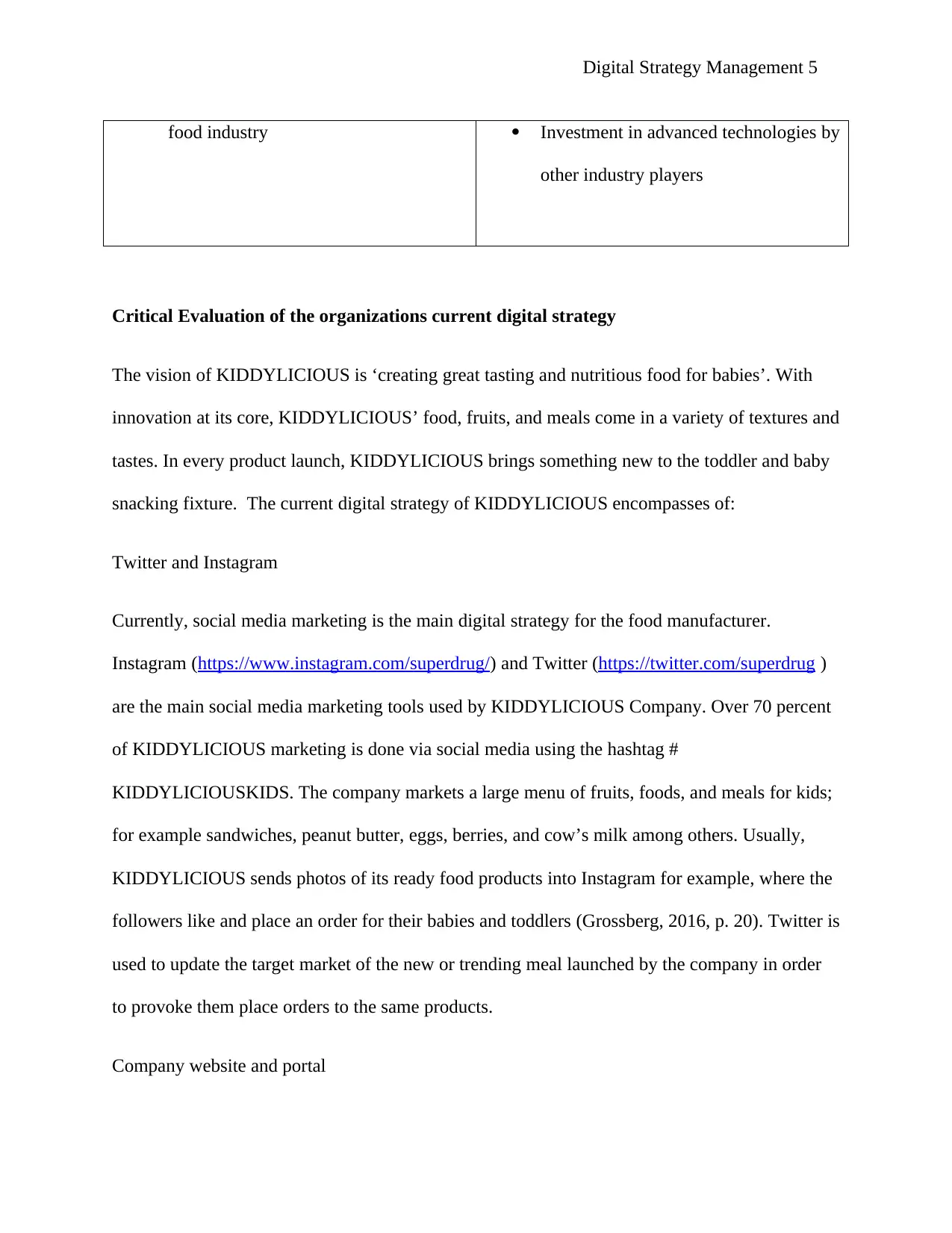
Digital Strategy Management 5
food industry Investment in advanced technologies by
other industry players
Critical Evaluation of the organizations current digital strategy
The vision of KIDDYLICIOUS is ‘creating great tasting and nutritious food for babies’. With
innovation at its core, KIDDYLICIOUS’ food, fruits, and meals come in a variety of textures and
tastes. In every product launch, KIDDYLICIOUS brings something new to the toddler and baby
snacking fixture. The current digital strategy of KIDDYLICIOUS encompasses of:
Twitter and Instagram
Currently, social media marketing is the main digital strategy for the food manufacturer.
Instagram (https://www.instagram.com/superdrug/) and Twitter (https://twitter.com/superdrug )
are the main social media marketing tools used by KIDDYLICIOUS Company. Over 70 percent
of KIDDYLICIOUS marketing is done via social media using the hashtag #
KIDDYLICIOUSKIDS. The company markets a large menu of fruits, foods, and meals for kids;
for example sandwiches, peanut butter, eggs, berries, and cow’s milk among others. Usually,
KIDDYLICIOUS sends photos of its ready food products into Instagram for example, where the
followers like and place an order for their babies and toddlers (Grossberg, 2016, p. 20). Twitter is
used to update the target market of the new or trending meal launched by the company in order
to provoke them place orders to the same products.
Company website and portal
food industry Investment in advanced technologies by
other industry players
Critical Evaluation of the organizations current digital strategy
The vision of KIDDYLICIOUS is ‘creating great tasting and nutritious food for babies’. With
innovation at its core, KIDDYLICIOUS’ food, fruits, and meals come in a variety of textures and
tastes. In every product launch, KIDDYLICIOUS brings something new to the toddler and baby
snacking fixture. The current digital strategy of KIDDYLICIOUS encompasses of:
Twitter and Instagram
Currently, social media marketing is the main digital strategy for the food manufacturer.
Instagram (https://www.instagram.com/superdrug/) and Twitter (https://twitter.com/superdrug )
are the main social media marketing tools used by KIDDYLICIOUS Company. Over 70 percent
of KIDDYLICIOUS marketing is done via social media using the hashtag #
KIDDYLICIOUSKIDS. The company markets a large menu of fruits, foods, and meals for kids;
for example sandwiches, peanut butter, eggs, berries, and cow’s milk among others. Usually,
KIDDYLICIOUS sends photos of its ready food products into Instagram for example, where the
followers like and place an order for their babies and toddlers (Grossberg, 2016, p. 20). Twitter is
used to update the target market of the new or trending meal launched by the company in order
to provoke them place orders to the same products.
Company website and portal
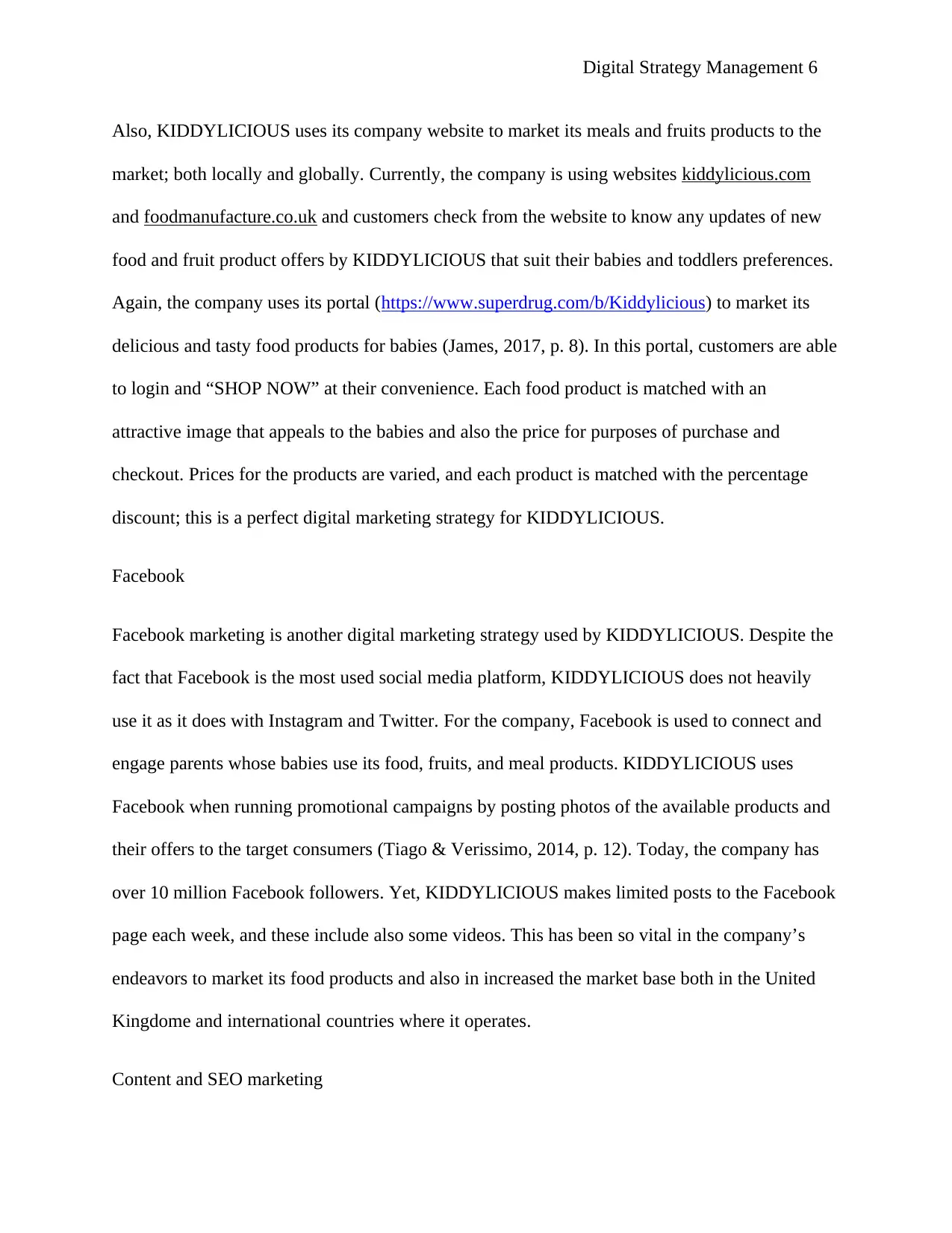
Digital Strategy Management 6
Also, KIDDYLICIOUS uses its company website to market its meals and fruits products to the
market; both locally and globally. Currently, the company is using websites kiddylicious.com
and foodmanufacture.co.uk and customers check from the website to know any updates of new
food and fruit product offers by KIDDYLICIOUS that suit their babies and toddlers preferences.
Again, the company uses its portal (https://www.superdrug.com/b/Kiddylicious) to market its
delicious and tasty food products for babies (James, 2017, p. 8). In this portal, customers are able
to login and “SHOP NOW” at their convenience. Each food product is matched with an
attractive image that appeals to the babies and also the price for purposes of purchase and
checkout. Prices for the products are varied, and each product is matched with the percentage
discount; this is a perfect digital marketing strategy for KIDDYLICIOUS.
Facebook
Facebook marketing is another digital marketing strategy used by KIDDYLICIOUS. Despite the
fact that Facebook is the most used social media platform, KIDDYLICIOUS does not heavily
use it as it does with Instagram and Twitter. For the company, Facebook is used to connect and
engage parents whose babies use its food, fruits, and meal products. KIDDYLICIOUS uses
Facebook when running promotional campaigns by posting photos of the available products and
their offers to the target consumers (Tiago & Verissimo, 2014, p. 12). Today, the company has
over 10 million Facebook followers. Yet, KIDDYLICIOUS makes limited posts to the Facebook
page each week, and these include also some videos. This has been so vital in the company’s
endeavors to market its food products and also in increased the market base both in the United
Kingdome and international countries where it operates.
Content and SEO marketing
Also, KIDDYLICIOUS uses its company website to market its meals and fruits products to the
market; both locally and globally. Currently, the company is using websites kiddylicious.com
and foodmanufacture.co.uk and customers check from the website to know any updates of new
food and fruit product offers by KIDDYLICIOUS that suit their babies and toddlers preferences.
Again, the company uses its portal (https://www.superdrug.com/b/Kiddylicious) to market its
delicious and tasty food products for babies (James, 2017, p. 8). In this portal, customers are able
to login and “SHOP NOW” at their convenience. Each food product is matched with an
attractive image that appeals to the babies and also the price for purposes of purchase and
checkout. Prices for the products are varied, and each product is matched with the percentage
discount; this is a perfect digital marketing strategy for KIDDYLICIOUS.
Facebook marketing is another digital marketing strategy used by KIDDYLICIOUS. Despite the
fact that Facebook is the most used social media platform, KIDDYLICIOUS does not heavily
use it as it does with Instagram and Twitter. For the company, Facebook is used to connect and
engage parents whose babies use its food, fruits, and meal products. KIDDYLICIOUS uses
Facebook when running promotional campaigns by posting photos of the available products and
their offers to the target consumers (Tiago & Verissimo, 2014, p. 12). Today, the company has
over 10 million Facebook followers. Yet, KIDDYLICIOUS makes limited posts to the Facebook
page each week, and these include also some videos. This has been so vital in the company’s
endeavors to market its food products and also in increased the market base both in the United
Kingdome and international countries where it operates.
Content and SEO marketing
⊘ This is a preview!⊘
Do you want full access?
Subscribe today to unlock all pages.

Trusted by 1+ million students worldwide
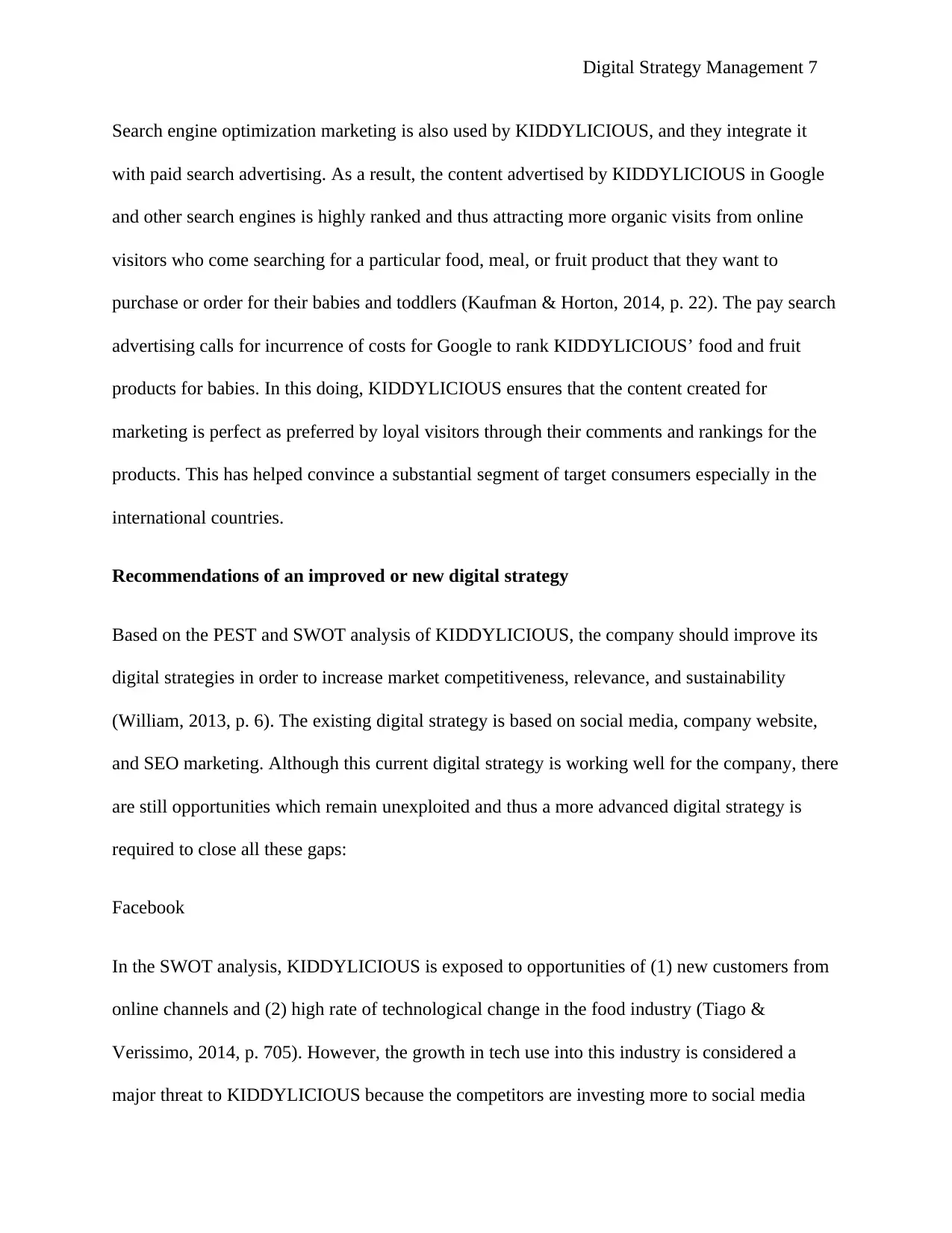
Digital Strategy Management 7
Search engine optimization marketing is also used by KIDDYLICIOUS, and they integrate it
with paid search advertising. As a result, the content advertised by KIDDYLICIOUS in Google
and other search engines is highly ranked and thus attracting more organic visits from online
visitors who come searching for a particular food, meal, or fruit product that they want to
purchase or order for their babies and toddlers (Kaufman & Horton, 2014, p. 22). The pay search
advertising calls for incurrence of costs for Google to rank KIDDYLICIOUS’ food and fruit
products for babies. In this doing, KIDDYLICIOUS ensures that the content created for
marketing is perfect as preferred by loyal visitors through their comments and rankings for the
products. This has helped convince a substantial segment of target consumers especially in the
international countries.
Recommendations of an improved or new digital strategy
Based on the PEST and SWOT analysis of KIDDYLICIOUS, the company should improve its
digital strategies in order to increase market competitiveness, relevance, and sustainability
(William, 2013, p. 6). The existing digital strategy is based on social media, company website,
and SEO marketing. Although this current digital strategy is working well for the company, there
are still opportunities which remain unexploited and thus a more advanced digital strategy is
required to close all these gaps:
Facebook
In the SWOT analysis, KIDDYLICIOUS is exposed to opportunities of (1) new customers from
online channels and (2) high rate of technological change in the food industry (Tiago &
Verissimo, 2014, p. 705). However, the growth in tech use into this industry is considered a
major threat to KIDDYLICIOUS because the competitors are investing more to social media
Search engine optimization marketing is also used by KIDDYLICIOUS, and they integrate it
with paid search advertising. As a result, the content advertised by KIDDYLICIOUS in Google
and other search engines is highly ranked and thus attracting more organic visits from online
visitors who come searching for a particular food, meal, or fruit product that they want to
purchase or order for their babies and toddlers (Kaufman & Horton, 2014, p. 22). The pay search
advertising calls for incurrence of costs for Google to rank KIDDYLICIOUS’ food and fruit
products for babies. In this doing, KIDDYLICIOUS ensures that the content created for
marketing is perfect as preferred by loyal visitors through their comments and rankings for the
products. This has helped convince a substantial segment of target consumers especially in the
international countries.
Recommendations of an improved or new digital strategy
Based on the PEST and SWOT analysis of KIDDYLICIOUS, the company should improve its
digital strategies in order to increase market competitiveness, relevance, and sustainability
(William, 2013, p. 6). The existing digital strategy is based on social media, company website,
and SEO marketing. Although this current digital strategy is working well for the company, there
are still opportunities which remain unexploited and thus a more advanced digital strategy is
required to close all these gaps:
In the SWOT analysis, KIDDYLICIOUS is exposed to opportunities of (1) new customers from
online channels and (2) high rate of technological change in the food industry (Tiago &
Verissimo, 2014, p. 705). However, the growth in tech use into this industry is considered a
major threat to KIDDYLICIOUS because the competitors are investing more to social media
Paraphrase This Document
Need a fresh take? Get an instant paraphrase of this document with our AI Paraphraser
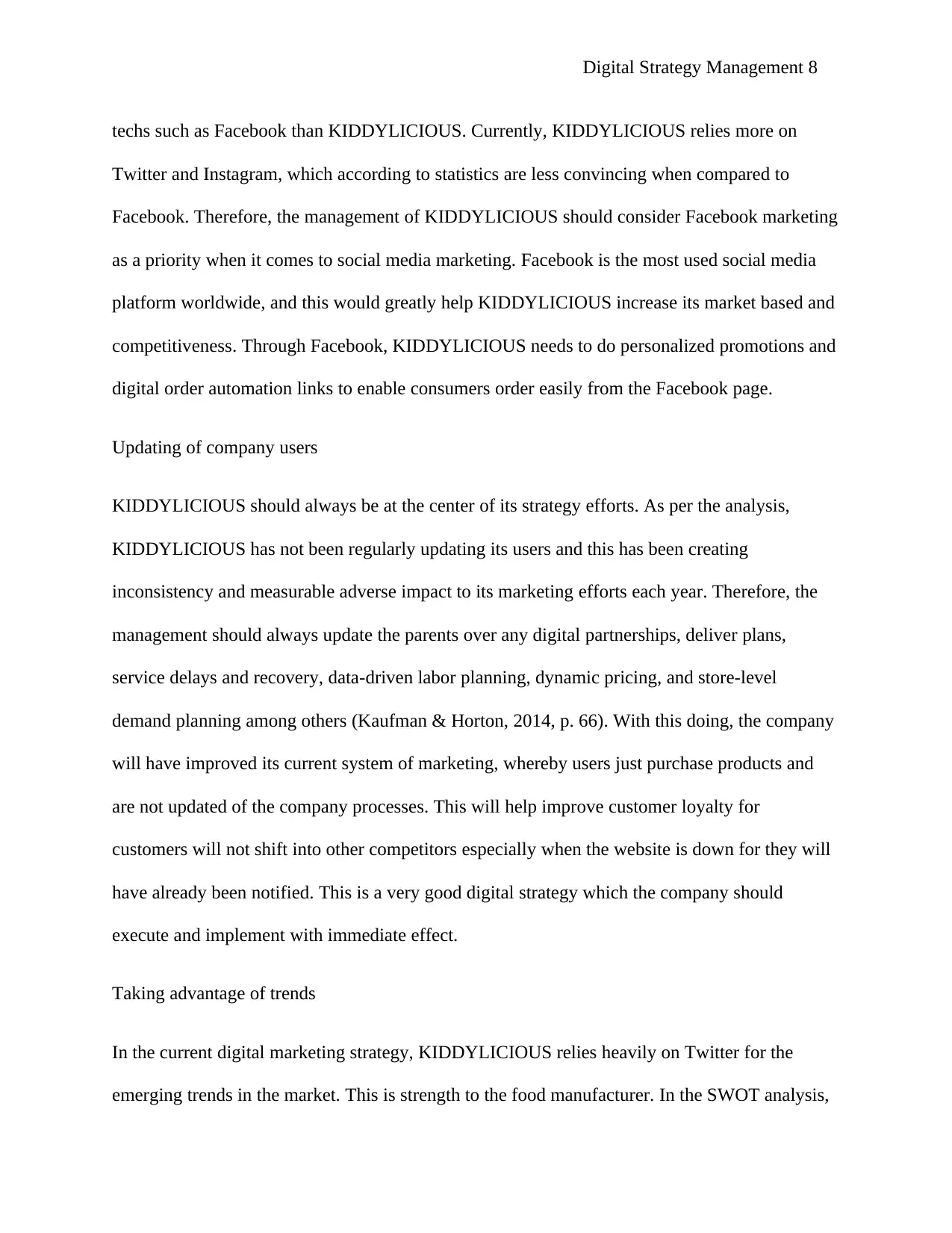
Digital Strategy Management 8
techs such as Facebook than KIDDYLICIOUS. Currently, KIDDYLICIOUS relies more on
Twitter and Instagram, which according to statistics are less convincing when compared to
Facebook. Therefore, the management of KIDDYLICIOUS should consider Facebook marketing
as a priority when it comes to social media marketing. Facebook is the most used social media
platform worldwide, and this would greatly help KIDDYLICIOUS increase its market based and
competitiveness. Through Facebook, KIDDYLICIOUS needs to do personalized promotions and
digital order automation links to enable consumers order easily from the Facebook page.
Updating of company users
KIDDYLICIOUS should always be at the center of its strategy efforts. As per the analysis,
KIDDYLICIOUS has not been regularly updating its users and this has been creating
inconsistency and measurable adverse impact to its marketing efforts each year. Therefore, the
management should always update the parents over any digital partnerships, deliver plans,
service delays and recovery, data-driven labor planning, dynamic pricing, and store-level
demand planning among others (Kaufman & Horton, 2014, p. 66). With this doing, the company
will have improved its current system of marketing, whereby users just purchase products and
are not updated of the company processes. This will help improve customer loyalty for
customers will not shift into other competitors especially when the website is down for they will
have already been notified. This is a very good digital strategy which the company should
execute and implement with immediate effect.
Taking advantage of trends
In the current digital marketing strategy, KIDDYLICIOUS relies heavily on Twitter for the
emerging trends in the market. This is strength to the food manufacturer. In the SWOT analysis,
techs such as Facebook than KIDDYLICIOUS. Currently, KIDDYLICIOUS relies more on
Twitter and Instagram, which according to statistics are less convincing when compared to
Facebook. Therefore, the management of KIDDYLICIOUS should consider Facebook marketing
as a priority when it comes to social media marketing. Facebook is the most used social media
platform worldwide, and this would greatly help KIDDYLICIOUS increase its market based and
competitiveness. Through Facebook, KIDDYLICIOUS needs to do personalized promotions and
digital order automation links to enable consumers order easily from the Facebook page.
Updating of company users
KIDDYLICIOUS should always be at the center of its strategy efforts. As per the analysis,
KIDDYLICIOUS has not been regularly updating its users and this has been creating
inconsistency and measurable adverse impact to its marketing efforts each year. Therefore, the
management should always update the parents over any digital partnerships, deliver plans,
service delays and recovery, data-driven labor planning, dynamic pricing, and store-level
demand planning among others (Kaufman & Horton, 2014, p. 66). With this doing, the company
will have improved its current system of marketing, whereby users just purchase products and
are not updated of the company processes. This will help improve customer loyalty for
customers will not shift into other competitors especially when the website is down for they will
have already been notified. This is a very good digital strategy which the company should
execute and implement with immediate effect.
Taking advantage of trends
In the current digital marketing strategy, KIDDYLICIOUS relies heavily on Twitter for the
emerging trends in the market. This is strength to the food manufacturer. In the SWOT analysis,
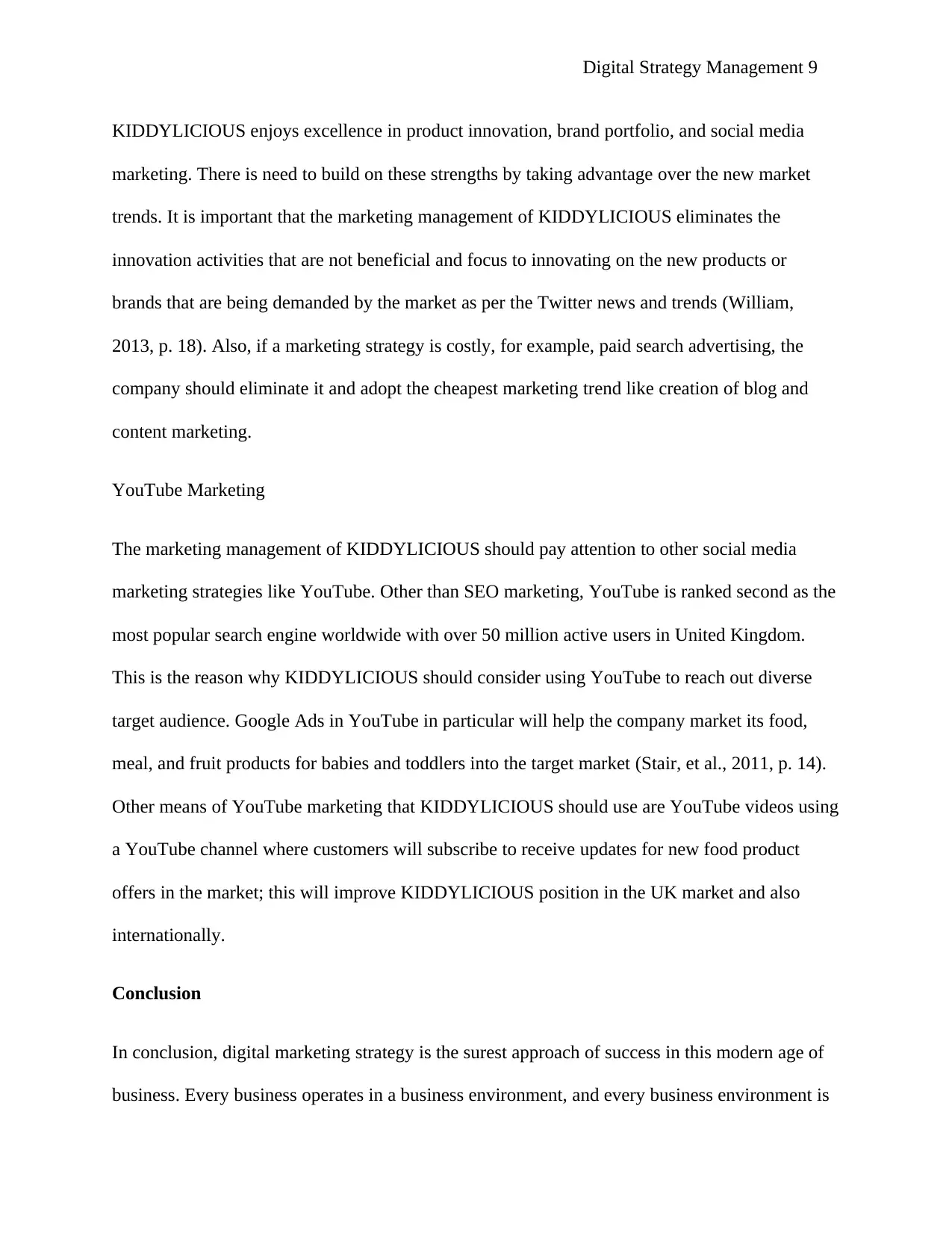
Digital Strategy Management 9
KIDDYLICIOUS enjoys excellence in product innovation, brand portfolio, and social media
marketing. There is need to build on these strengths by taking advantage over the new market
trends. It is important that the marketing management of KIDDYLICIOUS eliminates the
innovation activities that are not beneficial and focus to innovating on the new products or
brands that are being demanded by the market as per the Twitter news and trends (William,
2013, p. 18). Also, if a marketing strategy is costly, for example, paid search advertising, the
company should eliminate it and adopt the cheapest marketing trend like creation of blog and
content marketing.
YouTube Marketing
The marketing management of KIDDYLICIOUS should pay attention to other social media
marketing strategies like YouTube. Other than SEO marketing, YouTube is ranked second as the
most popular search engine worldwide with over 50 million active users in United Kingdom.
This is the reason why KIDDYLICIOUS should consider using YouTube to reach out diverse
target audience. Google Ads in YouTube in particular will help the company market its food,
meal, and fruit products for babies and toddlers into the target market (Stair, et al., 2011, p. 14).
Other means of YouTube marketing that KIDDYLICIOUS should use are YouTube videos using
a YouTube channel where customers will subscribe to receive updates for new food product
offers in the market; this will improve KIDDYLICIOUS position in the UK market and also
internationally.
Conclusion
In conclusion, digital marketing strategy is the surest approach of success in this modern age of
business. Every business operates in a business environment, and every business environment is
KIDDYLICIOUS enjoys excellence in product innovation, brand portfolio, and social media
marketing. There is need to build on these strengths by taking advantage over the new market
trends. It is important that the marketing management of KIDDYLICIOUS eliminates the
innovation activities that are not beneficial and focus to innovating on the new products or
brands that are being demanded by the market as per the Twitter news and trends (William,
2013, p. 18). Also, if a marketing strategy is costly, for example, paid search advertising, the
company should eliminate it and adopt the cheapest marketing trend like creation of blog and
content marketing.
YouTube Marketing
The marketing management of KIDDYLICIOUS should pay attention to other social media
marketing strategies like YouTube. Other than SEO marketing, YouTube is ranked second as the
most popular search engine worldwide with over 50 million active users in United Kingdom.
This is the reason why KIDDYLICIOUS should consider using YouTube to reach out diverse
target audience. Google Ads in YouTube in particular will help the company market its food,
meal, and fruit products for babies and toddlers into the target market (Stair, et al., 2011, p. 14).
Other means of YouTube marketing that KIDDYLICIOUS should use are YouTube videos using
a YouTube channel where customers will subscribe to receive updates for new food product
offers in the market; this will improve KIDDYLICIOUS position in the UK market and also
internationally.
Conclusion
In conclusion, digital marketing strategy is the surest approach of success in this modern age of
business. Every business operates in a business environment, and every business environment is
⊘ This is a preview!⊘
Do you want full access?
Subscribe today to unlock all pages.

Trusted by 1+ million students worldwide
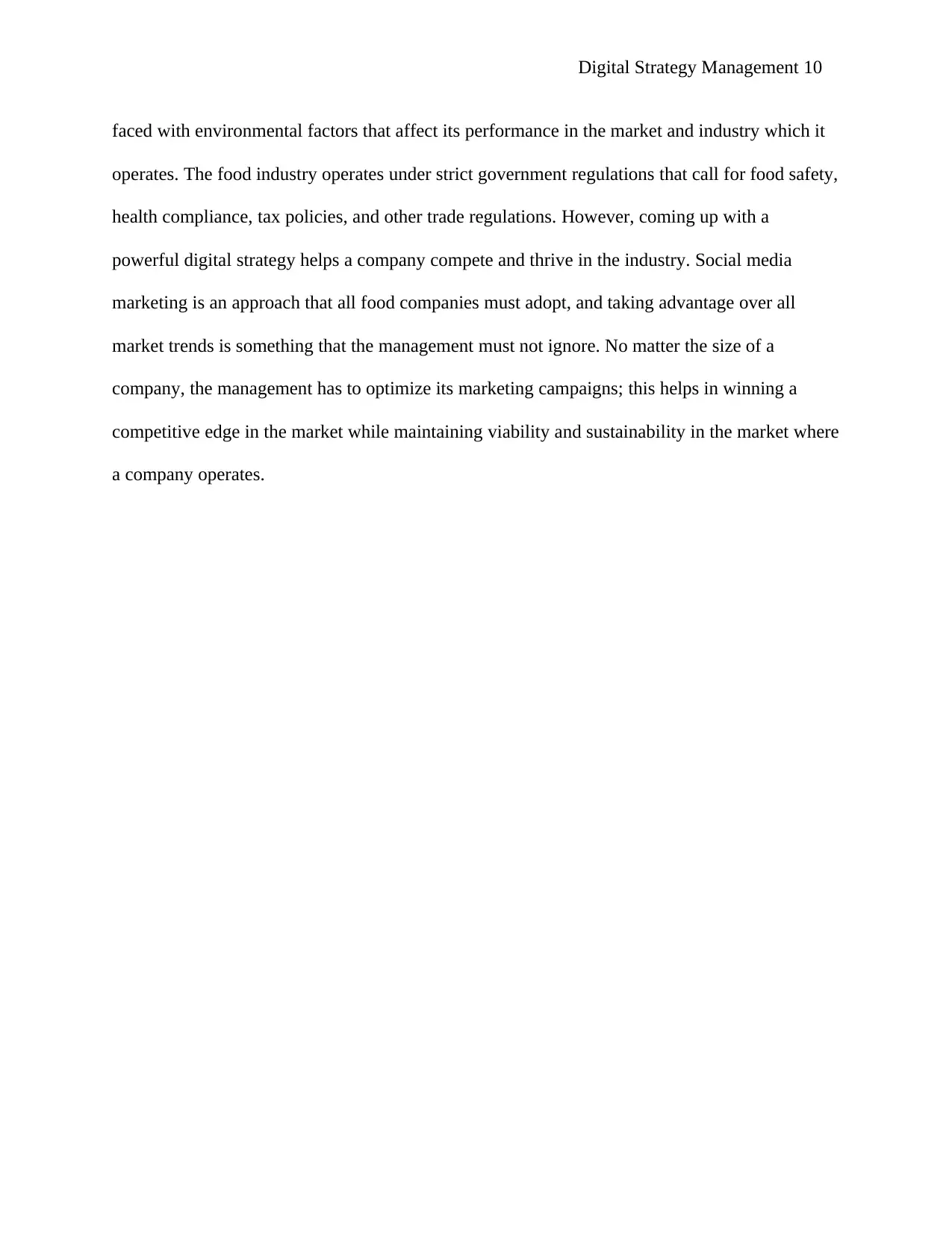
Digital Strategy Management 10
faced with environmental factors that affect its performance in the market and industry which it
operates. The food industry operates under strict government regulations that call for food safety,
health compliance, tax policies, and other trade regulations. However, coming up with a
powerful digital strategy helps a company compete and thrive in the industry. Social media
marketing is an approach that all food companies must adopt, and taking advantage over all
market trends is something that the management must not ignore. No matter the size of a
company, the management has to optimize its marketing campaigns; this helps in winning a
competitive edge in the market while maintaining viability and sustainability in the market where
a company operates.
faced with environmental factors that affect its performance in the market and industry which it
operates. The food industry operates under strict government regulations that call for food safety,
health compliance, tax policies, and other trade regulations. However, coming up with a
powerful digital strategy helps a company compete and thrive in the industry. Social media
marketing is an approach that all food companies must adopt, and taking advantage over all
market trends is something that the management must not ignore. No matter the size of a
company, the management has to optimize its marketing campaigns; this helps in winning a
competitive edge in the market while maintaining viability and sustainability in the market where
a company operates.
Paraphrase This Document
Need a fresh take? Get an instant paraphrase of this document with our AI Paraphraser
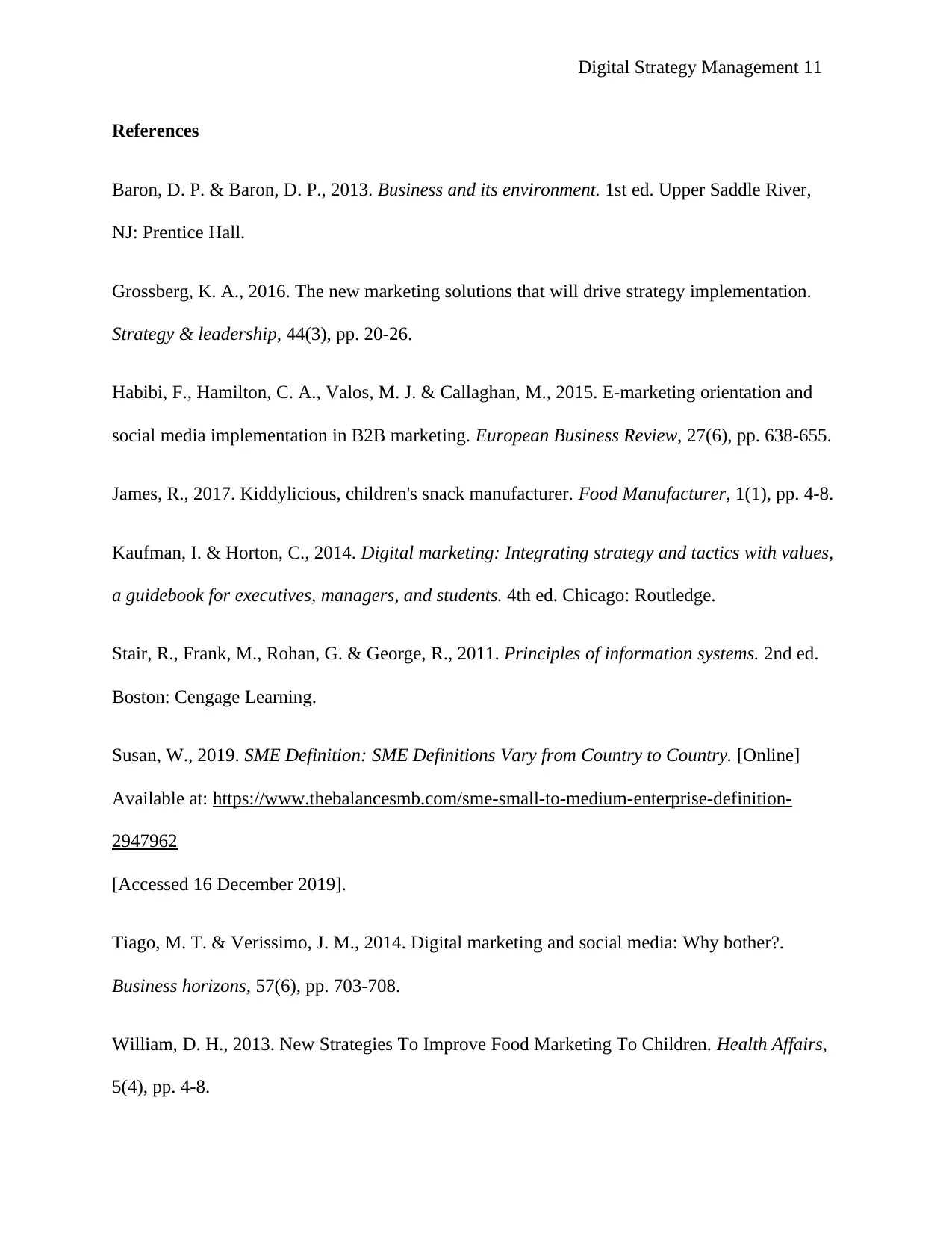
Digital Strategy Management 11
References
Baron, D. P. & Baron, D. P., 2013. Business and its environment. 1st ed. Upper Saddle River,
NJ: Prentice Hall.
Grossberg, K. A., 2016. The new marketing solutions that will drive strategy implementation.
Strategy & leadership, 44(3), pp. 20-26.
Habibi, F., Hamilton, C. A., Valos, M. J. & Callaghan, M., 2015. E-marketing orientation and
social media implementation in B2B marketing. European Business Review, 27(6), pp. 638-655.
James, R., 2017. Kiddylicious, children's snack manufacturer. Food Manufacturer, 1(1), pp. 4-8.
Kaufman, I. & Horton, C., 2014. Digital marketing: Integrating strategy and tactics with values,
a guidebook for executives, managers, and students. 4th ed. Chicago: Routledge.
Stair, R., Frank, M., Rohan, G. & George, R., 2011. Principles of information systems. 2nd ed.
Boston: Cengage Learning.
Susan, W., 2019. SME Definition: SME Definitions Vary from Country to Country. [Online]
Available at: https://www.thebalancesmb.com/sme-small-to-medium-enterprise-definition-
2947962
[Accessed 16 December 2019].
Tiago, M. T. & Verissimo, J. M., 2014. Digital marketing and social media: Why bother?.
Business horizons, 57(6), pp. 703-708.
William, D. H., 2013. New Strategies To Improve Food Marketing To Children. Health Affairs,
5(4), pp. 4-8.
References
Baron, D. P. & Baron, D. P., 2013. Business and its environment. 1st ed. Upper Saddle River,
NJ: Prentice Hall.
Grossberg, K. A., 2016. The new marketing solutions that will drive strategy implementation.
Strategy & leadership, 44(3), pp. 20-26.
Habibi, F., Hamilton, C. A., Valos, M. J. & Callaghan, M., 2015. E-marketing orientation and
social media implementation in B2B marketing. European Business Review, 27(6), pp. 638-655.
James, R., 2017. Kiddylicious, children's snack manufacturer. Food Manufacturer, 1(1), pp. 4-8.
Kaufman, I. & Horton, C., 2014. Digital marketing: Integrating strategy and tactics with values,
a guidebook for executives, managers, and students. 4th ed. Chicago: Routledge.
Stair, R., Frank, M., Rohan, G. & George, R., 2011. Principles of information systems. 2nd ed.
Boston: Cengage Learning.
Susan, W., 2019. SME Definition: SME Definitions Vary from Country to Country. [Online]
Available at: https://www.thebalancesmb.com/sme-small-to-medium-enterprise-definition-
2947962
[Accessed 16 December 2019].
Tiago, M. T. & Verissimo, J. M., 2014. Digital marketing and social media: Why bother?.
Business horizons, 57(6), pp. 703-708.
William, D. H., 2013. New Strategies To Improve Food Marketing To Children. Health Affairs,
5(4), pp. 4-8.

Digital Strategy Management 12
⊘ This is a preview!⊘
Do you want full access?
Subscribe today to unlock all pages.

Trusted by 1+ million students worldwide
1 out of 12
Related Documents
Your All-in-One AI-Powered Toolkit for Academic Success.
+13062052269
info@desklib.com
Available 24*7 on WhatsApp / Email
![[object Object]](/_next/static/media/star-bottom.7253800d.svg)
Unlock your academic potential
Copyright © 2020–2025 A2Z Services. All Rights Reserved. Developed and managed by ZUCOL.



